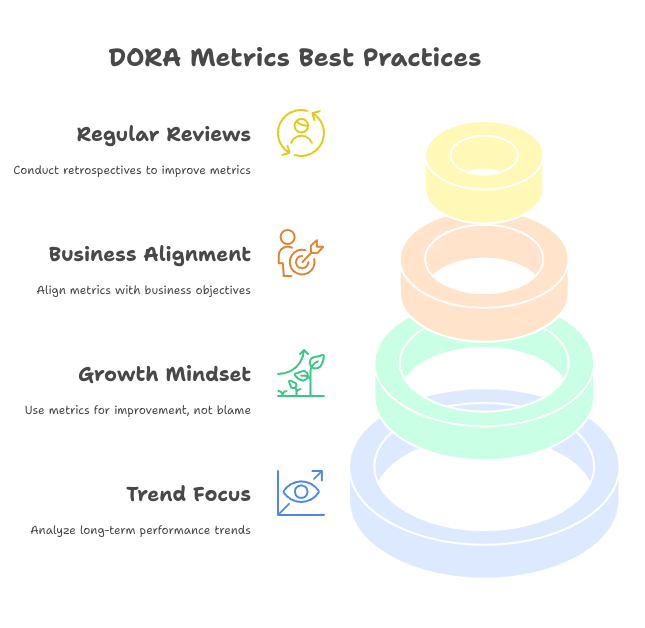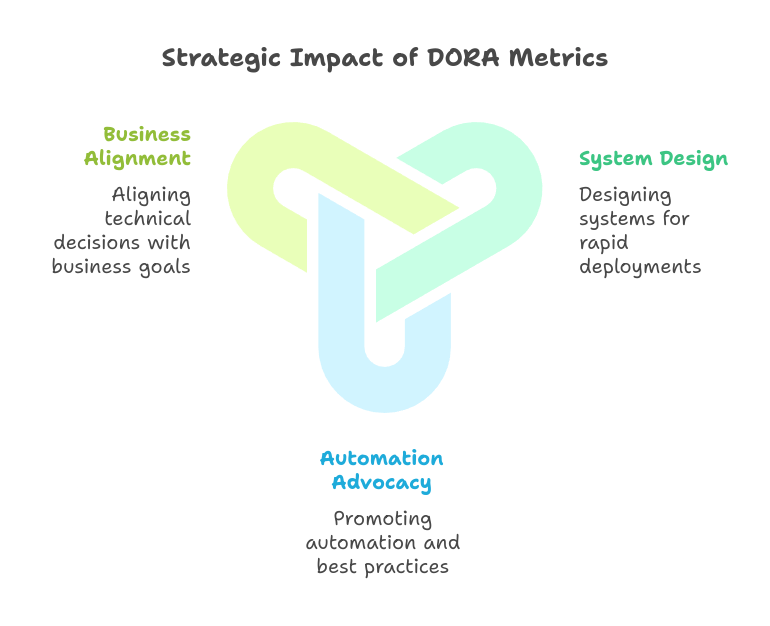In the fast-paced world of software development, teams are always looking for ways to deliver high-quality software faster. But how can you measure the effectiveness of your delivery process and identify areas for improvement? That’s where DORA metrics come into play.
These metrics, developed by the DevOps Research and Assessment (DORA) team, have become the gold standard for measuring software delivery performance. In this post, we’ll explore what DORA metrics are, how they work, and how you can use them to supercharge your software development process. We’ll also look at real-world example to bring these concepts to life.
What Are DORA Metrics?
DORA metrics are a set of four key indicators that help teams understand and optimize their software delivery performance. They’re designed to measure not only how quickly you can deliver software but also the quality and reliability of those deliveries. The four DORA metrics are:
- Deployment Frequency: How often your team deploys code to production. High-performing teams aim for frequent, small deployments.
- Lead Time for Changes: The time it takes for a code change to move from commit to production. This metric highlights the efficiency of your development process.
- Mean Time to Recovery (MTTR): The average time it takes to recover from a failure in production. A lower MTTR reflects a team’s ability to respond quickly to issues.
- Change Failure Rate: The percentage of deployments that result in a failure, such as a bug or an outage. This metric measures the quality and stability of your releases.

Why Do DORA Metrics Matter?
DORA metrics provide actionable insights into your team’s performance. Here are some of the benefits they bring:
- Improved Delivery Speed: By tracking deployment frequency and lead time, you can identify bottlenecks and streamline your processes.
- Higher Quality: Monitoring change failure rates ensures your releases are stable and reliable.
- Faster Incident Resolution: MTTR highlights how quickly your team can respond to and fix issues, minimizing downtime.
- Data-Driven Decision-Making: These metrics provide objective data that can guide your team’s priorities and resource allocation.
How to Measure DORA Metrics
To effectively measure DORA metrics, you’ll need the right tools and practices. Here’s a step-by-step guide to get started:
1. Automate Your Deployment Pipeline
Use tools like Jenkins, GitHub Actions, or GitLab CI/CD to track how often you deploy code. For example, if your team deploys daily, your deployment frequency is high. Automation ensures consistent tracking and reduces manual effort.
2. Track Lead Time for Changes
Integrate your version control system (e.g., Git) with a project management tool like Jira. This allows you to measure the time from when a developer commits code to when it’s deployed. For instance, if a feature branch is merged on Monday and deployed on Wednesday, the lead time is two days.
3. Monitor Mean Time to Recovery
Tools like PagerDuty or Splunk can help you track incidents and their resolution times. For example, if your system goes down at 2:00 PM and is restored by 3:30 PM, the MTTR is 90 minutes. Consistently low MTTR indicates a resilient team.
4. Calculate Change Failure Rate
Keep track of the number of failed deployments using tools like Datadog or New Relic. If your team deploys 100 times in a month and 5 of those deployments cause failures, your change failure rate is 5%.
Real-World Example
Let’s consider a fictional e-commerce company, FastCart, to see DORA metrics in action. FastCart’s engineering team wants to improve their delivery performance. Here’s how they apply DORA metrics:
- Deployment Frequency: FastCart’s team deploys updates to their checkout system twice a week. They aim to increase this to daily deployments by automating testing and reducing manual reviews.
- Lead Time for Changes: Currently, it takes FastCart’s developers an average of 10 days to get a feature from commit to production. By introducing a streamlined CI/CD pipeline, they reduce this to 3 days.
- Mean Time to Recovery: FastCart uses monitoring tools to detect production issues quickly. Initially, their MTTR was 4 hours, but with improved alerting and incident response practices, they bring this down to 1 hour.
- Change Failure Rate: With robust automated tests and better code reviews, FastCart reduces their change failure rate from 10% to 2%.
Best Practices for Using DORA Metrics
- Focus on Trends, Not Single Data Points: Look at long-term trends rather than daily metrics to get a clear picture of your performance.
- Encourage a Growth Mindset: Use metrics to identify areas for improvement, not to assign blame.
- Align Metrics with Business Goals: Ensure your improvements contribute to overall business objectives, like faster feature delivery or better customer satisfaction.
- Regularly Review Metrics: Hold retrospectives to discuss DORA metrics and brainstorm ways to improve.

Common Challenges and How to Overcome Them
- Resistance to Change: Educate stakeholders about the value of DORA metrics to gain support.
- Tool Overload: Choose tools that integrate seamlessly with your current tech stack.
- Overemphasis on Numbers: Don’t sacrifice team morale or innovation for the sake of metrics.
Why DORA Metrics Matter for Software Architects
As a software architect, you play a key role in shaping your team’s delivery processes. DORA metrics help you:
- Design systems that support rapid, reliable deployments.
- Advocate for automation and best practices in DevOps.
- Align technical decisions with business goals by providing measurable outcomes.

Conclusion
DORA metrics offer a clear and actionable way to measure and improve your team’s software delivery performance. By focusing on deployment frequency, lead time, MTTR, and change failure rates, you can identify areas for improvement and drive meaningful change. Start small, measure consistently, and watch your team evolve into a high-performing powerhouse.
Have you used DORA metrics in your projects?
